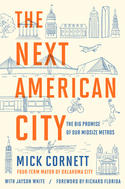The plunging of birth rates has emerged as one of the most significant demographic trends. For the first time, there appears to be the prospect of nations that will become materially smaller in population as a result. For example, the latest projections from the Japan’s National Institute of Population and Social Security Research are that by 2115, the population will be only 50.5 million, down 60 percent from the present 126 million. read more »
Geography
Highest Fertility & Gains Concentrated in US Midwest and South
- Login to post comments
The Sacred Cul-de-Sac: Lakewood
In 1901 John D. Rockefeller of Standard Oil (now ExxonMobil) began purchasing hundreds of acres of land around the town of Lakewood, New Jersey an hour and a half south of New York. He then built a thirty bedroom, twenty bathroom country estate. Lakewood was a prosperous year round vacation destination complete with swimming, tennis, golf, and ice skating, as well as numerous hotels, fine restaurants, a theater, and many large elegant homes. read more »
- Login to post comments
Summer Travel Offers Insights Into What Drives Economic Growth
Why do we travel? Alain de Botton suggests in his engaging meditation on this question, The Art of Travel, that it’s the human craving for variety that impels us to leave home and incur the headaches of exploring the world. read more »
- Login to post comments
Edge Cities in China: Suzhou
Nearly three decades ago, journalist and educator Joel Garreau coined a new term, “Edge cities,” to describe the rise of commercial centers outside the downtowns (central business districts or CBDs) largely of the United States (Note 1). read more »
Welcome to Park Forest
Recently a follower sent me an interesting e-mail. He said he recently re-read The Organization Man by William Whyte, originally published in 1956. The suburban Chicago village of Park Forest, IL, about 30 miles directly south of the Loop, figured prominently in the book, as an example of the kind of Levittown-style suburban development that was taking America by storm at the time. In checking in about Park Forest today, he found that yesterday’s model of white middle class and middle management homogeneity is now a black-majority community. read more »
Ten Years After Lehman Collapsed, We’re Still Screwed
The collapse of Lehman Brothers 10 years ago today began the financial crisis that crippled and even killed for some the American dream as we had known it. Donald Trump might be starting to change that, at least for Americans who aren’t determined to remain in our bluest and priciest cities. read more »
- Login to post comments
“Middle America” in America’s Urban Century
In the late 1990s and the early Aughts, when the last Gen Xers and the first Millennials were launching into their adult lives, “Urban America” was a very different place. On many fronts, the choices young ambitious graduates had were fast becoming limitless, save on one key front: the cities where they could reasonably want to live. read more »
- Login to post comments
A Generation Plans An Exodus From California
California is the great role model for America, particularly if you read the Eastern press. Yet few boosters have yet to confront the fact that the state is continuing to hemorrhage people at a higher rate, with particular losses among the family-formation age demographic critical to California’s future. read more »
- Login to post comments
Beginnings, Middles, and Ends
I was recently invited to give a talk at a housing conference down in Los Angeles. Once again my fellow speakers engaged in the usual arguments. Aging Baby Boomers asserted that we need to keep building more 1957 style suburban homes on the edge of the metroplex because that’s what people want and can afford, particularly once they marry and have children. Then a group of Millennials sang their sad song of high prices and a lack of options in the places they really want to live. read more »
- Login to post comments
Ethnic Flight
For the first decades of mass suburbanization, the movement from urban cores often has been referred to as “white flight” (Note 1). But now major metropolitan area living patterns indicate something much different, what might be called “ethnic flight.” The four largest racial and ethnic groups (called “ethnicities” in this article) are overwhelmingly concentrated outside the urban core, in the suburbs and Exurbs. These four largest ethnicities are White Only Not Hispanic, African American Only, Asian Only and Hispanics (Note 2). read more »
- Login to post comments




















